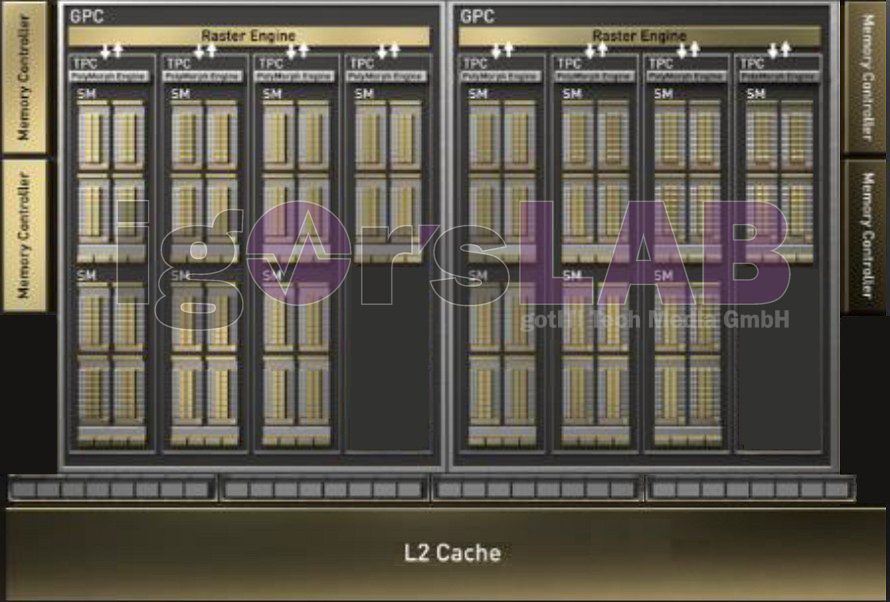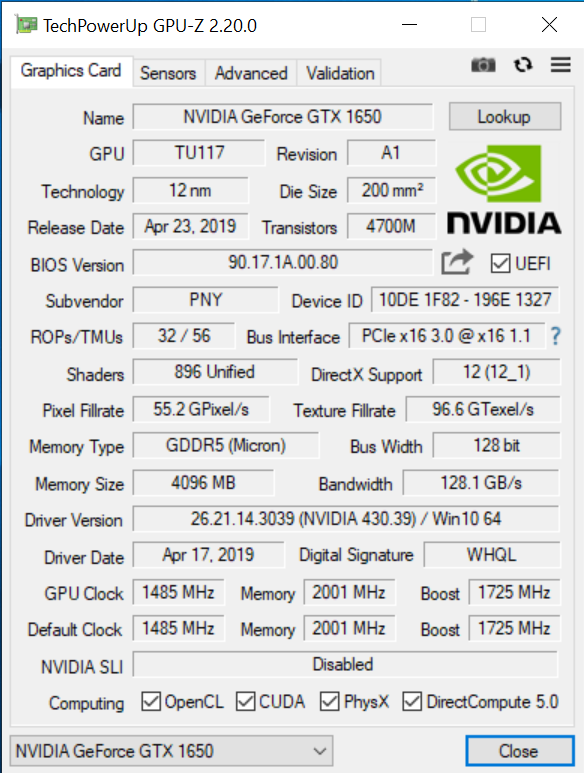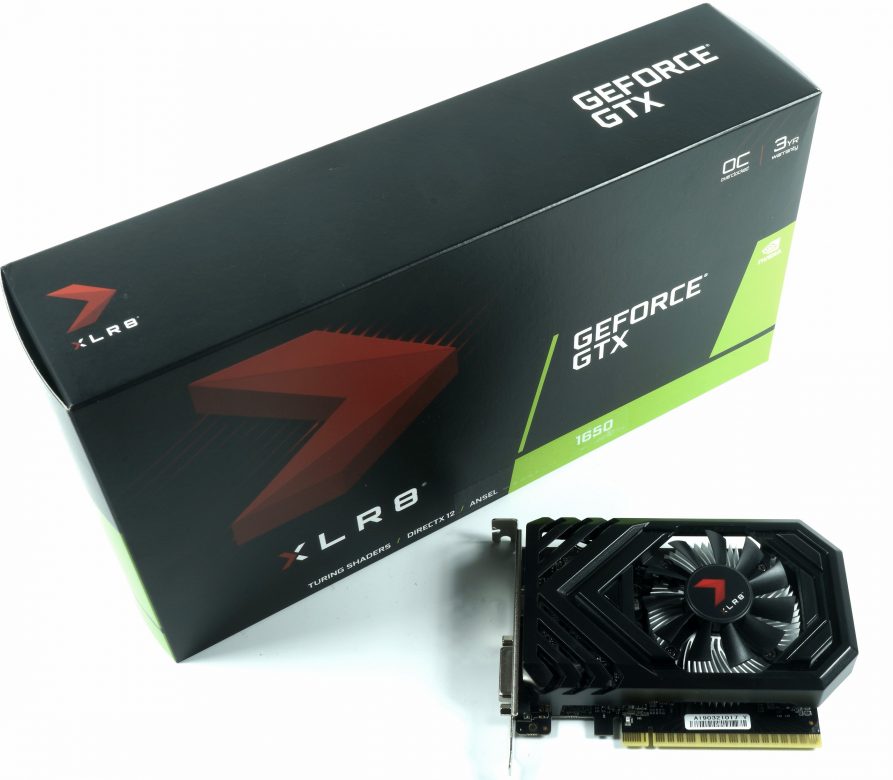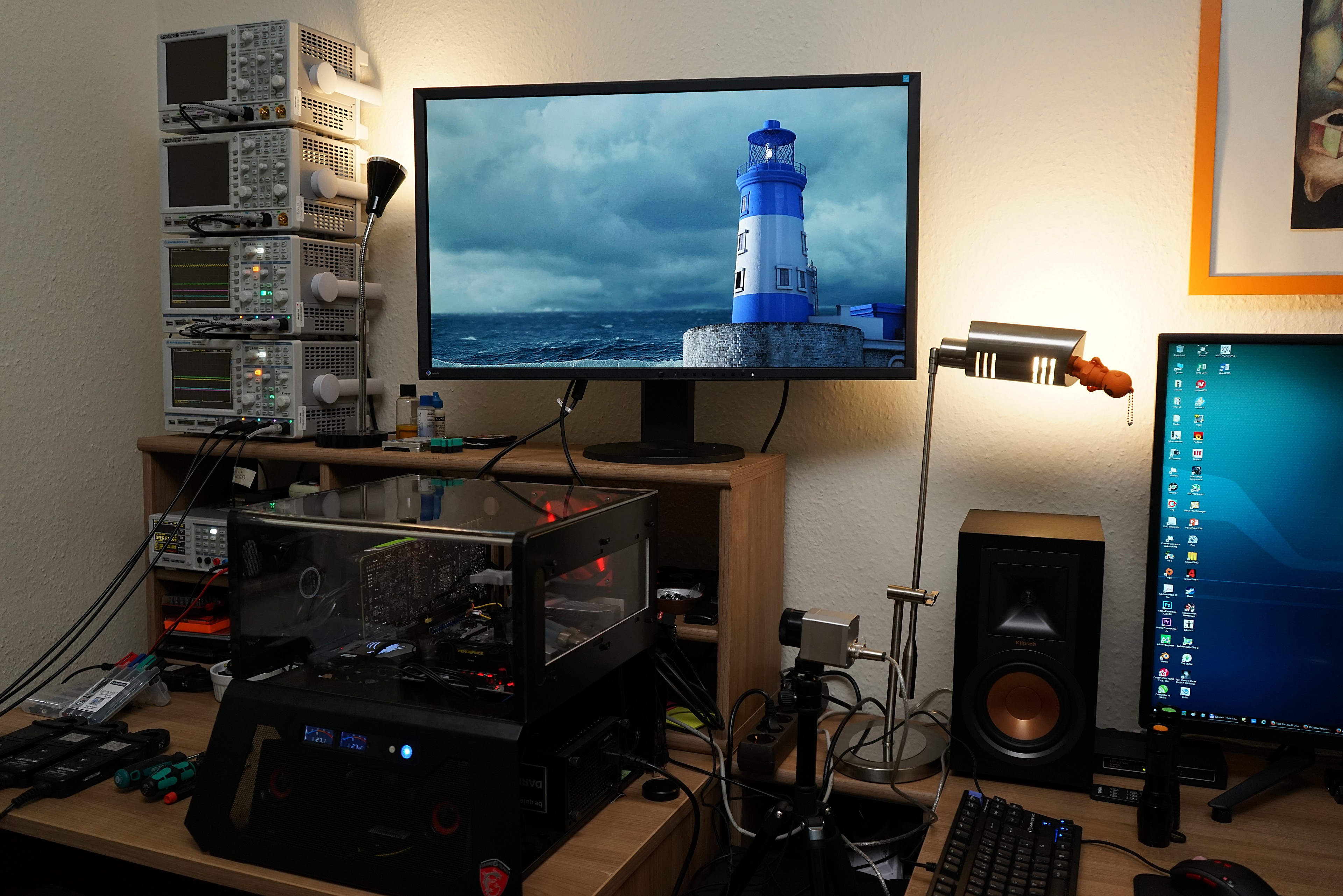It is still incomprehensible to me why at the launch of the GeForce GTX 1650 almost exclusively models with external power supply were offered for testing. The cards, which in my view are much more interesting, are exactly the cards without external supply. If an almost tiny card comes out, it is all the more interesting for upstarts in the entry-level segment. Even if we are in the entry-level area here, such a test is more worthwhile than one of the 1001. Bling bling gamer kiddie version.
The only 240 grams light card measures in its length 14.3 cm gross from the outer edge slot panel to the end of the radiator cover. It is as 3 cm thick and only 9.5 cm high (from the top of the motherboard slot to the top edge of the radiator cover). The black radiator cover is kept in the usual XLR8 style and rather inconspicuous. The customer has to do without RGB completely, but this is to be hurt. Only one digital DVI and ONE HDMI 2.0 port are available as connectors.
The small 6.5 cm fan with the 11 rotor blades is almost lost on this card. It is not PWM-controlled, so I had to log the speeds of the 2-pin fan with the laser. Of course, there is no longer a backplate in this price range. With a little less than 150 Euros, the card is certainly the better GeForce GTX 1050 Ti, because it is also sometimes much faster. It’s the typical cost-down model, but even that can have its charm when you need just that.
The TU117-300 is not a real full-end
Well, let’s see what PNY and Nvidia offer us here. While Turing’s streaming multiprocessors consist of fewer CUDA cores than Pascal’s, the design compensates for this in part by distributing more streaming multiprocessors (SM) on the GPU. The Turing architecture assigns each set of 16 CUDA cores, one scheduler, and one disposition unit per 16 CUDA cores (such as Pascal).
Four of these 16-core groupings include the SM, 96 KB cache, which can be configured as 64 KB L1/32 KB of shared memory, or vice versa, and four texture units. As a result, the TU117-300 of the GeForce GTX 1650 with its 896 CUDA cores has such 14 SM. If you followed Nvidia’s nomenclature for the chip designation, a larger TU117-400 would only be logical.
But the theory also confirms the fact that the TU117-300 is not the maximum expansion. I have modified and shortened a scheme of the TU116-300 of the GeForce GTX 1660 to fit exactly for the TU117-300 of the GeForce GTX 1650. We see very nicely the gaps in the two GPC, so that the TU117-400, if it will exist, could appear with 16 SM, which should also run out as a result of 1024 CUDA-Cores. Unfortunately, Nvidia does not reveal whether this could be a GeForce GTX 1650 (“We generally don’t talk about unannounced products”).

Because Turing has twice as many schedulers as Pascal, only one statement needs to be issued to the CUDA cores in every second cycle. In between, there is enough room to send a different instruction to any other device, including the INT32 cores. This is no different with the GTX 1650 than with the other larger Turing cards. Nvidia splits these 14 SM into two graphics processing clusters. In addition, 14 SMs, each with four associated texture units, total56 texture units for the entire GPU.
In addition to the Shaders and the Unified Cache of the Turing Architecture, the TU117 also supports a pair of algorithms called Content Adaptive Shading and Motion Adaptive Shading, which together are called variable-rate shading. I have already written a longer introduction to the launch of the GeForce RTX 2080 (Ti). Nvidia has also revealed that it is replacing the tensor cores with dedicated FP16 cores to enable the GeForce GTX 1660 Ti to process semi-precision operations at twice the rate of FP32. Nvidia has also noted that the TU117 is the smallest Turing chip that will be able to use the DXR share in the drivers.
Four 32-bit memory controllers end up giving the TU117 an aggregated 128-bit bus that operates the four GDDR5 modules at up to 128 GB/s. However, this is a considerable bandwidth disadvantage compared to the GTX 1660 and is even lower than the level of the old GeForce GTX 1060, but also significantly higher than that of the GeForce GTX 1050 Ti.

The following table shows the relevant models and a fictitious GeForce GTX 1650 Ti:
| Nvidia GeForce GTX 1060 |
Nvidia GeForce GTX 1660 Ti 6 GB |
Nvidia GeForce GTX 1660 6 GB |
Nvidia GeForce GTX 1650 |
Pny GeForce GTX 1650 XLR8 OC |
Nvidia GeForce GTX 1650 Ti |
|
| Architecture (GPU) |
GP106 | TU116-400 | TU116-300 | TU-117-300 | TU-117-300 | TU117-400 |
| CUDA Cores |
1280 | 1536* | 1280* | 896 | 896 | 1024 |
| Tensor Cores |
No | No | No | No | No | No |
| RT Cores |
No | No | No | No | No | No |
| Texture Units |
180 | 96 | 80 | 56 | 56 | 64 |
| Base Clock Rate |
1506 MHz | 1500 MHz | 1530 MHz | 1485 MHz | 1485 | ? |
| GPU Boost Rate |
1708 MHz | 1770 MHz | 1785 MHZ | 1665 MHz | 1725 | ? |
| Storage expansion |
6 GB GDDR5 | 6 GB GDDR6 | 6 GB GDDR5 | 4GB GDDR5 | 4GB GDDR5 | 4GB GDDR5 |
| Storage bus |
192-bit | 192-bit | 192-bit | 128-bit | 128-bit | 128-bit |
| Memory clock |
4000 MHz | 6000 MHz | 4000 MHz | 4000 MHz | 4000 MHz |
4000 MHz |
| Rops |
48 | 48 | 48 | 32 | 32 | 32 |
| L2 Cache |
1.5 MB | 1.5 MB | 1.5 MB | 1 MB | 1 MB | 1 MB |
| Board design | PG161 | PG165 | PG174 | Custom | PG174 | |
| Tdp |
120 W | 120 W | 120 W | 75 W | 75 W | ? |
| Transistors |
4.4 billion | 6.6 billion | 6.6 billion | 4.7 billion | 4.7 billion | 4.7 billion |
| Sli |
No | No | No | No | No | No |
Test system and measurement methods
I have already described the new test system and the methodology in the basic article “How we test graphics cards, as of February 2017″ (English: “How We Test Graphics Cards”) in great detail and therefore, for the sake of simplicity, now only refers to this detailed Description. So if you want to read everything again, you are welcome to do so.
If you are interested, the summary in table form quickly provides a brief overview:
| Test systems and measuring rooms | |
|---|---|
| Hardware: |
Intel Core i7-7700K (analogous to TH US) MSI Z270 Gaming Pro Carbon AC 16GB KFA2 DDR4 4000 Hall Of Fame @DDR4 3200 1x 1 TByte Toshiba OCZ RD400 (M.2, System SSD) 2x 960 GByte Toshiba OCZ TR150 (Storage, Images) Be Quiet Dark Power Pro 11, 850-watt power supply |
| Cooling: |
Alphacool Ice Block XPX 5x Be Quiet! Silent Wings 3 PWM (Closed Case Simulation) Thermal Grizzly Kryonaut (for cooler change) |
| Housing: |
Lian Li PC-T70 with expansion kit and modifications Modes: Open Benchtable, Closed Case |
| Monitor: | Eizo EV3237-BK |
| Power consumption: |
non-contact DC measurement on the PCIe slot (Riser-Card) non-contact DC measurement on the external PCIe power supply Direct voltage measurement on the respective feeders and on the power supply 2x Rohde & Schwarz HMO 3054, 500 MHz multi-channel oscillograph with memory function 4x Rohde & Schwarz HZO50, current togor adapter (1 mA to 30 A, 100 KHz, DC) 4x Rohde & Schwarz HZ355, touch divider (10:1, 500 MHz) 1x Rohde & Schwarz HMC 8012, digital multimeter with storage function |
| Thermography: |
Optris PI640, infrared camera PI Connect evaluation software with profiles |
| Acoustics: |
NTI Audio M2211 (with calibration file) Steinberg UR12 (with phantom power for the microphones) Creative X7, Smaart v.7 own low-reflection measuring room, 3.5 x 1.8 x 2.2 m (LxTxH) Axial measurements, perpendicular to the center of the sound source(s), measuring distance 50 cm Noise in dBA (Slow) as RTA measurement Frequency spectrum as a graph |
| Operating system | Windows 10 Pro (1809, all updates) |












































Kommentieren